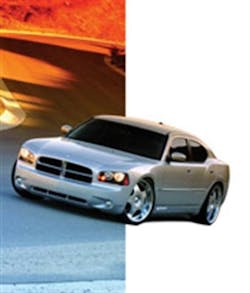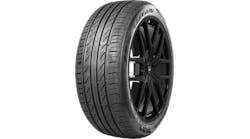Tire/wheel plus-sizing: Changing the look also changes the performance
The approach offered by plus-size tire selection offers your customers benefits both in terms of appearance and performance. While maintaining the original equipment tire overall diameter (necessary to allow proper operation of the speedometer, ABS, traction control and vehicle stability control systems), plus-sizing allows you to install large rim diameters, wider tires and tires that feature shorter sidewalls.
From an appearance standpoint, this means that you can feature more wheel and less tire sidewall height, providing a "sporty" to "extreme" visual statement.
From a performance standpoint, this allows your customer to utilize a wider tire (which means a larger tread contact patch for greater traction) and a shorter sidewall. The shorter the sidewall, the less compliant the tire will be in turns, where lateral forces are at work. This means quicker steering response and crisper handling.
Keep in mind that this isn't an invitation to run any size package that your customer might wish. Limitations will include tire size availability and available body and chassis clearance. Also, even if a plus-size tire of your customer's choice is available, he needs to be aware of the consequences of getting too radical in terms of sidewall height. Remind him that generally speaking, the shorter the sidewall, the stiffer the tire will be, so if couch-comfort is his goal, he can create a less-than-desirable harsh ride by choosing a notably shorter sidewall.
[PAGEBREAK]
In addition, he needs to be aware of the road hazard potential. After all, the shorter the tire sidewall, the closer the wheel rim will be to the pavement (a Plus-One fitment places the wheel rim one-half inch closer to the pavement; a Plus-Two places the wheel rim one inch closer to the ground, etc.). This translates into a less-forgiving environment when encountering potholes and other road obstructions, because the closer the rim is to the ground, the higher the chance of rim damage.
Running a substantially larger diameter wheel mated to a short-sidewall tire definitely looks cool (depending on the visual statement you desire), but your customer needs to be aware of the potential shortcomings if he gets too carried away. With these cautions in mind, help your customer choose plus-sizing with care.
Plus sizing changes
Plus-Zero: This maintains the original wheel rim diameter, but increases tire section width by 10mm, and drops the aspect ratio by five points.
For example, if the vehicle was originally equipped with 205/55R15 tires, your customer could keep the same wheels and move to a 215/50R15 tire. This provides a slight increase in tread contact patch, along with a slightly shorter sidewall for quicker steering response and less lateral lean, while maintaining the original overall tire diameter.
If your customer is concerned with his budget, this move will save him bucks, since it does not require wheel replacement.
Plus-One: Now we can begin to use a larger wheel.
A Plus-One move requires an increase of 10mm in section width, a reduction of aspect ratio of 10 points, and an increase in wheel rim diameter by one inch. If the original setup featured 185/65R14 tires (with overall diameter of 23.47 inches), this would move him into a set of 195/55R15 tires. (In theory, if that size is not available, he could move to a set of 205/50R15 tires, which may have an overall diameter of 23.07 inches).
[PAGEBREAK]
Plus-Two: A Plus-Two move would require a 20mm increase in section width, a 20-point drop in aspect ratio and a two-inch increase in wheel diameter, as compared to the original package.
Example: Moving from 185/65R14 would place him into a size 205/45R16 (since that size is, indeed, available). This is an example of where the theoretical math works out.
Plus-Three and beyond: OK, now we're moving into some serious stuff. As in Plus-One or Plus-Two upgrades, we move up yet another inch in wheel diameter (in this case, increasing the original wheel diameter by three inches). We still need to maintain the original overall tire diameter and we need to maintain sufficient load index.
However, determining the tire section width and aspect ratio gets a bit trickier, since the "rule of thumb" used in determining Plus-One and Plus-Two fitments is basically tossed out of the window.
When considering a Plus-Three or greater upgrade, we can't blindly add a set number of millimeters to section width and drop aspect ratio by a set number of points. Beyond Plus-One and Plus-Two, larger rim diameters and the limitation of practically available tire sizes make the old standard formula non-practical.
In other words, if your customer wants a Plus-Three, you don't automatically look for a tire that is 30mm wider in section width and 30 points lower in aspect ratio, because that specific tire size may not exist.
Instead, whenever moving to a Plus-Three or beyond, simply review the manufacturer's tire sizing chart to find a tire that:
1. matches the new rim diameter,
2. maintains the desired overall OE tire diameter, and
3. matches or goes beyond the OE tire load index.
As an example of a Plus-Three upgrade, moving from 195/65R15 (with an overall diameter of 25.0 inches) might require choosing a 225/30R18 or a 215/40R18 (with an overall diameter of 24.8 inches).
[PAGEBREAK]
As an example of a Plus-Five move, let's say that you're dealing with a 2005 Caddy Escalade originally fitted with 265/70R17 tires (31.5 inch overall tire diameter). While in theory a Plus-Five change would require a 315/20R17, that size may not exist, so moving to a 275/45R22 that features a 31.8 inch overall diameter would fill the bill.
Tire overall diameters, along with all other specifications, are available by perusing the tiremaker's specification charts for each model of tire. Just keep in mind that for a true plus change, you need to closely match the original tire's overall diameter, and always pay attention to load ratings and tire/wheel clearance.
Minus-sizing
Minus-sizing is the reverse of plus-sizing. Instead of moving to a larger diameter wheel and wider tire with a shorter sidewall, as you would in a plus move, you move to a narrower tire with a taller sidewall. In either case, when plus-sizing or minus-sizing, you still must maintain the original overall tire diameter.
Why would you want to move to a taller, more pliant sidewall and a narrower tread and cross section? Simple: to plow through snow easier and more efficiently.
The wider the tire, the greater the area of mass that attacks snow on the road surface. This tends to make the tires ride over the snow instead of digging through the snow. Basically, it's the snow version of hydroplaning (we could refer to this as snowskiplaning... just kidding).
So, if the vehicle is currently equipped with wide, low-profile tires and your customer wants to optimize traction and control in winter conditions, you can employ a minus-sizing approach.
In order to minus-size (let's say you plan to use a Minus-One approach), select a wheel size that is one inch smaller in diameter, and couple this with a tire that features a higher aspect ratio (taller sidewall and narrower section width) that still matches the original overall diameter.
To cite an example provided by The Tire Rack, if a 2003 Volkswagen Jetta GLX VR6 was originally equipped with 205/55R16 tires, a Minus-One move would involve changing to 15-inch wheels mated to 195/65R15 tires. (If the same car was equipped with the optional 225/45HR17 tires, moving to the 15-inch package would represent a Minus-Two change.) Moving to a minus size will enhance snow traction and represent a cost-savings compared to the purchase of original-size replacement tires.
[PAGEBREAK]
Naturally, as long as you're creating a winter tire/wheel package anyway, it only makes sense to sell the customer a dedicated winter tire in the process, in order to maximize his or her car's snow and ice traction.
Precautions regarding plus- or minus-sizing
In order to avoid problems with speedometer calibration, ABS, traction control and electronic stability control, the replacement tires should feature the same overall diameter/rolling circumference as the original-equipment tires.
However, it is widely accepted that a variance of 2% to 3% or less (depending on which tire or auto maker you talk to) should pose no adverse effects on ABS, traction control or vehicle stability control system operation. This gives your customer a bit of leeway in case the replacement tires of choice don't exactly match the originals in terms of overall diameter.
Make sure that the intended replacement tire will fit onto the intended wheel rim width. Always adhere to the tire manufacturer's recommendation concerning appropriate rim width for any given tire.
Never install tires that feature a lower load rating than that of the original equipment tires. Always choose a tire that features an equal or higher load rating.
Never use an inflation pressure that is lower than that recommended by the vehicle maker for its original equipment tires. Also, if the vehicle manufacturer specifies different inflation pressure for front tires as compared to rear tires, always follow the same relative pressure difference.
If standard load rated tires are to be replaced with extra-load rated tires, inflation pressure may require a slight boost (see chart).
The speed rating of the replacement tires must equal or be higher than that of the original equipment tires.
Naturally, always verify adequate body and chassis clearance of the tire/wheel package whenever you deviate from the original equipment tire and/or wheel dimensions.
NOTE: If the customer plans to add tires chains, consider the additional clearance required to prevent chains from contacting chassis or body surfaces.
[PAGEBREAK]
Calculating tire dimensions
1. Width X aspect ratio = section height.
2. Section height X 2 = combined section height.
3. Combined section height + wheel diameter = overall tire diameter.
Example: 185/60R14.
1. 185mm X 0.60 = 111mm (section height).
2. 111mm X 2 = 222mm (combined section height).
3. 222mm + 355.6mm = 577.6mm or 22.74 inches (overall tire diameter).
When reading a tire size, the first number represents the section width in millimeters.
To convert millimeters to inches, divide by 25.4.
The second number represents the aspect ratio. This is a ratio of sidewall height to section width. In the example (courtesy of The Tire Rack), the tire is 7.28 inches wide. By multiplying section width by the aspect ratio, you can determine the height of one sidewall. So, in this example, 185 X 0.60 = 111mm sidewall height (in inches: 7.28 inches X 0.60 = 4.36 inches).
To determine the outside diameter of a tire, multiply sidewall height by two and add wheel diameter. For example, if the individual sidewall height is 4.36 inches: 4.36 inches X 2 = 8.72 inches.
By adding 8.72 inches to the 14-inch wheel diameter, the tire's overall diameter should be 22.72 inches.
Vehicle stability control and tire/wheel upgrades: The latter won't affect the former as long as the OE tire diameter remains the same
Will upgrading to high performance or ultra-high performance tires and aftermarket wheels affect a vehicle's stability control system? In a word, no.
[PAGEBREAK]
As long as you maintain overall tire diameter within the parameters of the vehicle's anti-lock braking system's guidelines, the customer shouldn't experience any problems.
In basic terms, a vehicle stability control system (the car makers have their own names for this approach) takes advantage of the ABS to control individual wheel braking. A yaw sensor (or deceleration sensor) senses when the vehicle leans fore/aft and laterally. If lean becomes excessive in a turn, the system calls upon the ABS to judiciously apply the appropriate brake(s) to help maintain control.
For example, if the vehicle enters a turn and the front end begins to push (under-steer), the system may begin to apply the inside brake(s) to aid in vehicle turn-in. You get the gist. In essence, it's a way to help an unskilled driver control the vehicle as it would be controlled by a more skilled driver.
With that said, upgrading to tires that are wider, stickier and/or stiffer shouldn't mess things up.
In theory, and according to the car makers we contacted, any change will affect the system operation, since the vehicle stability control system is optimized for a specific size, brand and model of tire.
In theory, if the system sees any "different" behavior in terms of traction or response rate, the system might apply the ABS at a non-optimal or different rate. So, according to the car makers, when a tire replacement is needed, you should only install the original type tire(s). Again, in theory.
What about the real world? We spoke with The Tire Rack's John Rastetter, a highly respected and experienced tire tech expert, to obtain his opinion on the matter. As part of Rastetter's responsibilities as director of information services, he oversees testing on all of the tires that his firm carries, on a variety of vehicles, on the company's private test facility.
Rastetter said he has not experienced any "driveability" problems when swapping up to higher-performance tires, regardless of sidewall height or traction rating. He did mention that with some dedicated snow tires (softer sidewalls), his drivers have seen a few instances where individual wheels "hiccup" during activation, but they've seen no problems with stiffer, stickier tires.
"The only caution when upgrading to plus sizes," Rastetter noted, "is that you want to make sure that the OE overall tire diameter remains the same, which includes cars that feature different OE sizes front and rear. If you upgrade to a plus size, just make sure that you keep the same ratio. For example, if the rear OE tires are 3% bigger in diameter as compared to the front tires, you need to maintain that same ratio when upgrading."




